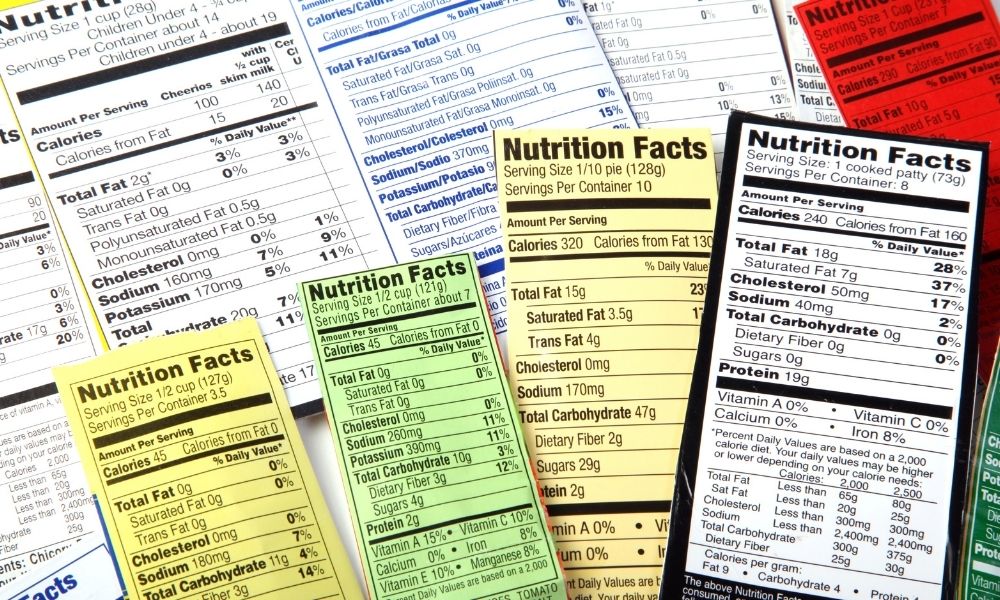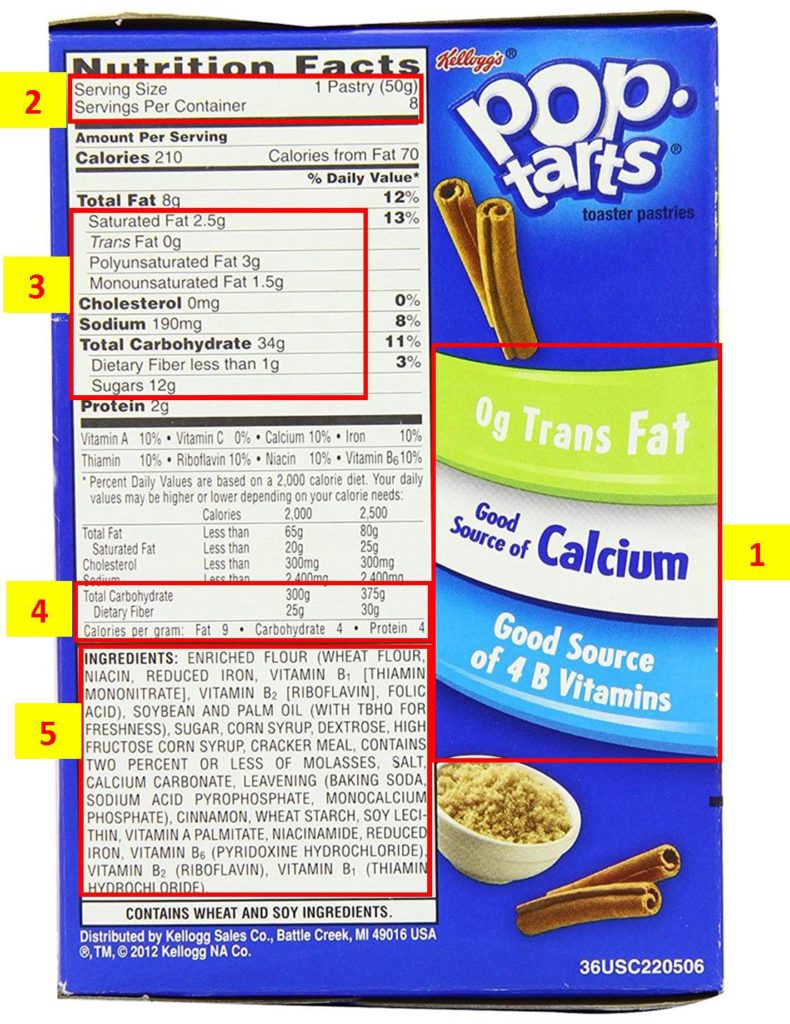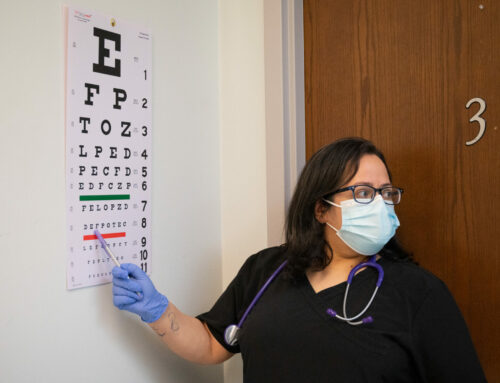News
Understanding Food Nutrition Labels

It’s National Nutrition Month!
The foods we buy offer lots of important information about their nutritional value right on the package.
But do you know how to read that information to make decisions about what to eat?
HHC’s Health Education Coordinator, Claire Brady offers 5 key tips, with the help of a Pop Tarts package.
1. Don’t believe the health claims on the front of the package!
- Health claims on the front of food packages only show a few positive aspects of a product’s nutrition and promote them, to make the food appear healthier than it really is.
- This Pop Tarts package, for example, advertises that it contains several vitamins and minerals, including B vitamins and calcium. But, only small amounts of these vitamins were added to the recipe to add a few redeeming qualities to an otherwise unhealthy food.
2. Pay attention to the serving size!
- The serving size will tell you the size of a single serving and the total number of servings per container (package).
- The serving size of Pop Tarts is 1 pastry, with each individual package containing 2 Pop Tarts. If you eat both, you have to multiply each category on the label by two, to get 420 calories, 16g of fat, 5g of saturated fat, 380g of sodium, and 24g of sugar. Yikes! It becomes clear at this point that this is not a healthy choice for breakfast!
3. Avoid foods with too much of the three S’s on the nutrition label: saturated fat, sodium, and sugar.
But how much is too much?
- Saturated Fat: The FDA recommends 20g or less of saturated fat per day, so avoid foods with more than three or four grams per serving. Most saturated fat in our diets comes from meat and dairy, so eating more plant foods and unprocessed foods can help you avoid eating too much saturated fat!
- Sugar: Sugar is tricky because labels do not indicate how much sugar is added to a food, versus how much occurs naturally from ingredients like fruit and milk. Added sugar, which has lots of names, including any type of syrup and any chemical name ending with “-ose”, should be limited to 6-9 tsp, or 24-36g, a day—less than a 12 oz can of Coke. There are 24g of sugar in these pop tarts, which is as much sugar as a child should consume in a day!
Sodium: A handy trick to determine if a food has a healthy amount of sodium is to compare the milligrams of sodium to the number of calories in the food. If the number of milligrams of sodium is within 100 of the number of calories, than it’s a healthy amount of sodium. In the case of the pop tarts, the 190 mg of sodium is right in line with the 210 calories, so this food is not overly high in sodium.
4. Higher amounts of fiber and protein are good!
- Fiber helps promote digestive health and lower cholesterol. Protein is important for building muscle and keeping your body running. Both of these nutrients keep you full, too. But just because a food has plenty of protein and/or fiber does not necessarily mean it’s healthy—you still have to watch out for sugar, saturated fat, and sodium!
5. Read the ingredients list.
- If a food has a very long ingredients list, especially with lots of words that are difficult to pronounce, it’s a sign that the food is highly processed and doesn’t contain much nutritional value. Short ingredients lists full of familiar words are your best bets.
- Ingredients are listed in order of quantity, so the most prevalent ingredients in each food are listed first. So if sugar, or enriched wheat flour (the stuff in white bread, and Pop Tarts) are high up on the list, the food is likely low in nutritional value. If whole wheat or oats or nuts or another whole food you can pronounce are first, that is a good sign.
- Look out for unhealthy ingredients that often hide on the label. The words “hydrogenated oils” indicate that the food has some quantity of trans-fat, and they are best avoided altogether. It’s also important to look out for the alternative words for sugar that I listed earlier—any type of syrup and any word ending in “-ose.”
Want to learn more?
It’s National Nutrition Month!
The foods we buy offer lots of important information about their nutritional value right on the package.
But do you know how to read that information to make decisions about what to eat?
HHC’s Health Education Coordinator, Claire Brady offers 5 key tips, with the help of a Pop Tarts package.
1. Don’t believe the health claims on the front of the package!
- Health claims on the front of food packages only show a few positive aspects of a product’s nutrition and promote them, to make the food appear healthier than it really is.
- This Pop Tarts package, for example, advertises that it contains several vitamins and minerals, including B vitamins and calcium. But, only small amounts of these vitamins were added to the recipe to add a few redeeming qualities to an otherwise unhealthy food.
2. Pay attention to the serving size!
- The serving size will tell you the size of a single serving and the total number of servings per container (package).
- The serving size of Pop Tarts is 1 pastry, with each individual package containing 2 Pop Tarts. If you eat both, you have to multiply each category on the label by two, to get 420 calories, 16g of fat, 5g of saturated fat, 380g of sodium, and 24g of sugar. Yikes! It becomes clear at this point that this is not a healthy choice for breakfast!
3. Avoid foods with too much of the three S’s on the nutrition label: saturated fat, sodium, and sugar.
But how much is too much?
- Saturated Fat: The FDA recommends 20g or less of saturated fat per day, so avoid foods with more than three or four grams per serving. Most saturated fat in our diets comes from meat and dairy, so eating more plant foods and unprocessed foods can help you avoid eating too much saturated fat!
- Sugar: Sugar is tricky because labels do not indicate how much sugar is added to a food, versus how much occurs naturally from ingredients like fruit and milk. Added sugar, which has lots of names, including any type of syrup and any chemical name ending with “-ose”, should be limited to 6-9 tsp, or 24-36g, a day—less than a 12 oz can of Coke. There are 24g of sugar in these pop tarts, which is as much sugar as a child should consume in a day!
Sodium: A handy trick to determine if a food has a healthy amount of sodium is to compare the milligrams of sodium to the number of calories in the food. If the number of milligrams of sodium is within 100 of the number of calories, than it’s a healthy amount of sodium. In the case of the pop tarts, the 190 mg of sodium is right in line with the 210 calories, so this food is not overly high in sodium.
4. Higher amounts of fiber and protein are good!
- Fiber helps promote digestive health and lower cholesterol. Protein is important for building muscle and keeping your body running. Both of these nutrients keep you full, too. But just because a food has plenty of protein and/or fiber does not necessarily mean it’s healthy—you still have to watch out for sugar, saturated fat, and sodium!
5. Read the ingredients list.
- If a food has a very long ingredients list, especially with lots of words that are difficult to pronounce, it’s a sign that the food is highly processed and doesn’t contain much nutritional value. Short ingredients lists full of familiar words are your best bets.
- Ingredients are listed in order of quantity, so the most prevalent ingredients in each food are listed first. So if sugar, or enriched wheat flour (the stuff in white bread, and Pop Tarts) are high up on the list, the food is likely low in nutritional value. If whole wheat or oats or nuts or another whole food you can pronounce are first, that is a good sign.
- Look out for unhealthy ingredients that often hide on the label. The words “hydrogenated oils” indicate that the food has some quantity of trans-fat, and they are best avoided altogether. It’s also important to look out for the alternative words for sugar that I listed earlier—any type of syrup and any word ending in “-ose.”
Want to learn more?














